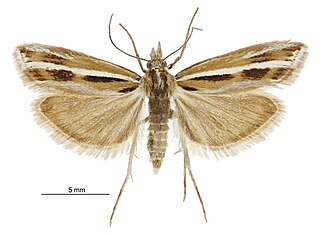
Crambidae comprises the grass moth family of lepidopterans. They are variable in appearance, with the nominal subfamily Crambinae taking up closely folded postures on grass stems where they are inconspicuous, while other subfamilies include brightly coloured and patterned insects that rest in wing-spread attitudes.

The Pyralidae, commonly called pyralid moths, snout moths or grass moths, are a family of Lepidoptera in the ditrysian superfamily Pyraloidea. In many classifications, the grass moths (Crambidae) are included in the Pyralidae as a subfamily, making the combined group one of the largest families in the Lepidoptera. The latest review by Eugene G. Munroe and Maria Alma Solis retain the Crambidae as a full family of Pyraloidea.

Ancylolomia is a genus of moths of the family Crambidae described by Jacob Hübner in 1825.

Conogethes is a genus of moths in the subfamily Spilomelinae of the family Crambidae. The currently 17 recognized species are distributed in the Indomalayan and Australasian realm.

Diplopseustis is a genus of snout moths in the subfamily Lathrotelinae of the family Crambidae. It was described in 1884 by Edward Meyrick with Cymoriza minimaButler, 1881 as its type species, which is now considered a synonym of Diplopseustis perieresalis.

Mnesictena is a genus of snout moths in the subfamily Spilomelinae, where it is placed in the tribe Udeini. The genus was erected by the English entomologist Edward Meyrick in 1884. The currently known seven species are exclusively found on New Zealand and the associated Antipodes Islands and Chatham Islands.

Palpita is a genus of moths of the family Crambidae. Members of the moth genus Stemorrhages may be very similar in appearance.

Protyparcha is a genus of moths of the family Crambidae. It contains only one species, Protyparcha scaphodes, which is endemic to New Zealand, where it is known only from Auckland Islands. Both the genus and species were described by Edward Meyrick in 1909.

Herpetogramma licarsisalis, commonly known as the grass webworm or pale sod-webworm, is a species of moth in the family Crambidae.
William Warren was an English entomologist who specialised in Lepidoptera.

Eudonia albafascicula is a moth of the family Crambidae. It was described by John Salmon in 1956. It is endemic to New Zealand, and can be found on Antipodes Island.

Orocrambus corruptus is a moth in the family Crambidae. It was described by Arthur Gardiner Butler in 1877. It is endemic to New Zealand. It is known from the lowland and intermontane region areas of eastern and central South Island. The habitat consists of poorly drained areas up to 750 meters and old pastures.

Orocrambus horistes is a moth in the family Crambidae. It was described by Edward Meyrick in 1902. O. horistes is endemic to New Zealand, where it has only been recorded from the Chatham Islands.

Orocrambus vulgaris is a moth in the family Crambidae. It was described by Arthur Gardiner Butler in 1877. It is endemic to New Zealand, where it has been recorded from the North Island and South Island. The species prefers habitat that consists of lowland and subalpine grasslands.

Orocrambus xanthogrammus is a moth in the family Crambidae. It was described by Edward Meyrick in 1883. It is endemic to New Zealand, where it has been recorded from the South Island and the eastern part of the North Island. The habitat of this species consists of shingle river beds.

Glaucocharis bipunctella is a moth in the family Crambidae. It was described by Francis Walker in 1866. This species is endemic to New Zealand and has been found in the Auckland region, in the southern parts of the North Island and in the Nelson region. It inhabits dense native forest. Larvae of this species have been raised on liverworts. Adults are on the wing in November to January and are attracted to light.

Glaucocharis epiphaea is a species of moth in the family Crambidae. It was described by Edward Meyrick in 1885. It is endemic to New Zealand and has been observed in both the North and South Islands. G. epiphaea prefers mountainous habitat and frequents very damp spots including alpine and subalpine moss bogs. Larvae feed on the moss Dawsonia superba. Adults are on the wing from September until March and are diurnal.

Antiscopa epicomia is a moth in the family Crambidae. This species was first described by Edward Meyrick. It is endemic to New Zealand and can be found throughout the country including on Auckland Island, Campbell Island, and the Kermadec Islands. It inhabits native forest, preferring damp, shaded forest ravines. Adults are variable in size and colouration and are on the wing all year but most frequently from October until March.
Diplopseustis selenalis is a moth in the family Crambidae. It was described by George Hampson in 1906 and it is found in New Guinea, where it has been recorded from Fergusson Island.
Lathrotelinae is a subfamily of the pyraloid family Crambidae described by John Frederick Gates Clarke in 1971. It currently comprises 45 species in six genera.

















